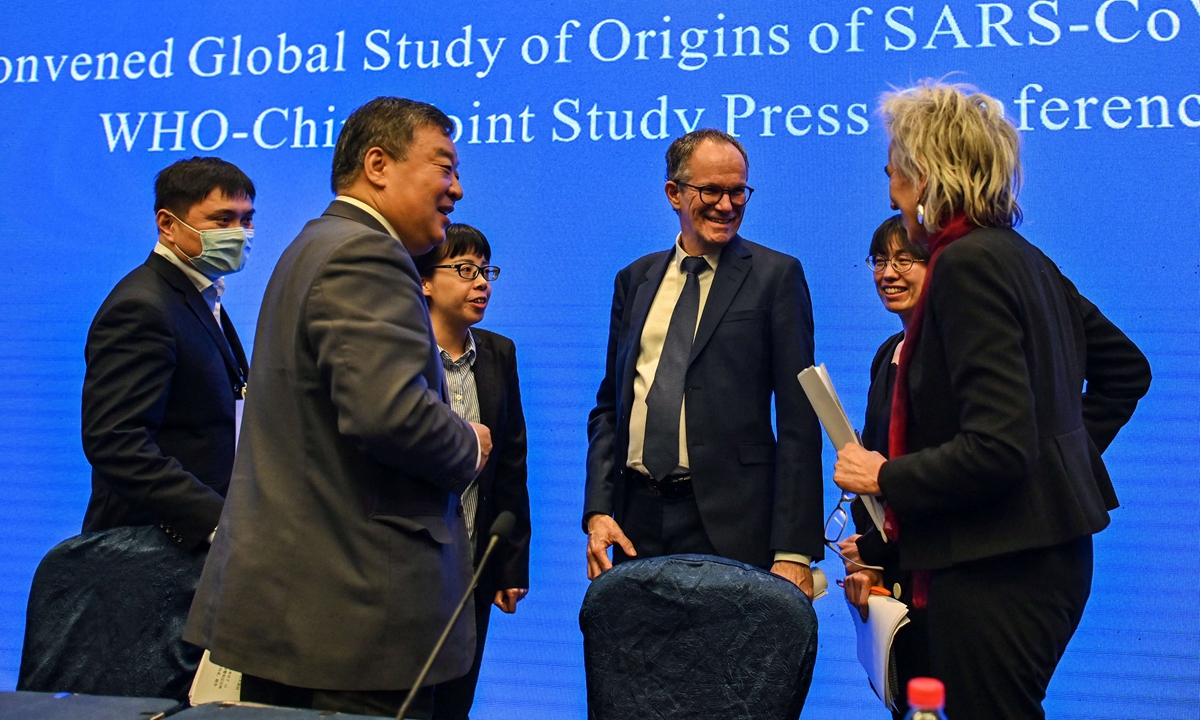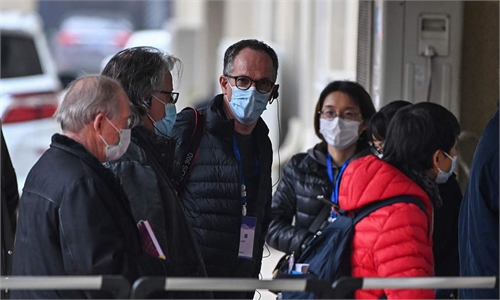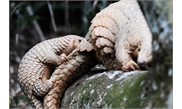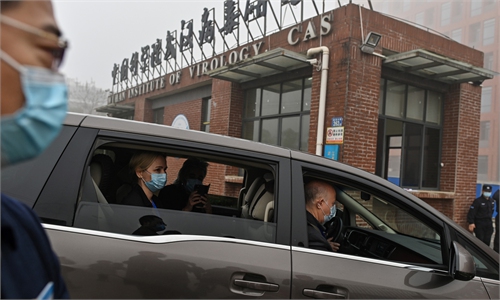Global experts scrutinize Southeast Asia as their target in tracing origins of coronavirus: WHO
Lab incident hypothesis 'extremely unlikely' in explaining virus transfer to humans

Peter Ben Embarek (center) talks with Liang Wannian (left) and Marion Koopmans (right) after a press conference to wrap up a visit by an international team of experts from the World Health Organization (WHO) in the city of Wuhan, in Central China's Hubei Province on Tuesday. Photo: AFP
The Huanan seafood market may not have been the original site of COVID-19 outbreak, bats and pangolin sample in Wuhan failed to provide evidence of coronavirus origins either, while viruses are extremely unlikely to leak from Wuhan labs according to a report jointly published by experts from China and World Health Organization (WHO) on Tuesday.
Experts from the China-WHO joint team tracing the coronavirus origins said investigations laid groundwork for coronavirus origins tracing elsewhere, and global tracing will not be limited to any single location.
The virus was most likely introduced from an intermediate host to humans. It's also likely that the virus was transmitted from frozen food, Peter Ben Embarek, a Danish food safety scientist leading the WHO team, said at a press conference of the WHO-convened Global Study of Origins of SARS-CoV-2 China Part held in Wuhan, Central China's Hubei Province.
Identifications of viral sequence showed bats and pangolins are not sufficiently similar to serve as the direct progenitor of the coronavirus. Bats and pangolin sample in Wuhan failed to indentify evidence of coronavirus and other samples from Chinese wild animals also failed to find related evidence, Liang Wannian, a member of the WHO-China joint study team, said at the press conference.
Antibody testing of 11,000 samples from animals including pigs, cows, goats, chickens and ducks came back negative, and swab testing of 12,000 samples from different animals also turned negative, Liang said.
The joint team is comprised of 17 Chinese experts and 17 international experts from 10 other countries, and they conducted 28-day research in Wuhan, Liang said.
Report shows Wuhan Huanan seafood market acted as a focus for transmission, but transmissions occurred elsewhere in Wuhan at same time. There is no evidence showing how the virus was introduced into Huanan seafood market, Liang said.
As the first case with the onset date on December 8, 2019 was not linked to Huanan seafood market, Liang said, noting that Huanan seafood market may not have been the first site for the COVID-19 outbreak.
After days of field studies in Wuhan, the joint team is looking at four hypotheses, including direct transmission from animal-to-human, virus jumping to human through an intermediate host, frozen food route-related transmission and lab-related transmission, Ben Embarek said.
"The initial findings suggest the lab incident was extremely unlikely to introduce the virus into the human population," he said.
The team discussed with managers and staff of many labs, and looked for labs of Wuhan Institute of Virology and found the virus unlikely leaked from these places, the Swiss expert added.
It also completely refutes the conspiracy theory raised by some anti-China hawks, like former US secretary of state Mike Pompeo, who has been accusing the Wuhan Institute of Virology of leaking the virus.
Liang also told the press conference that among all labs in Wuhan, there was no existing virus, indicating no way the virus could be leaked.
For further studies, Ben Embarek said that "we need to conduct more surveys of certain animals that could be reservoirs of the virus, and bats, not only in China."
Peter Daszak, the head of the New York-based EcoHealth Alliance and member of the WHO team, told the Global Times on Tuesday that the next location for their investigation is Southeast Asia.
"There was a virus from Thailand close to the SARS-CoV-2, and also Japan and Cambodia. Ecohealth Alliance is already starting our work in tracing their origins," Daszak said.
Daszak said there are important clues about the Huanan seafood market, including animal meat found in the market that includes characteristics that might potentially be susceptible to being infected with coronavirus although none tested positive.
As for the possibility of frozen food, Liang said COVID-19 virus survives a long time at low temperatures and can be carried long distances; there are several stores at Huanan seafood market selling cold-chain products, but it's unknown how first case linking the market to stores sold these products.
The WHO team also indentified vendors selling frozen animal products. Some were imported products in the Wuhan Huanan market, and there is a need to continue to follow leads and look at frozen food supply chains, Ben Embarek said.
"It's important to make sure we are not geopolitically bound, as the virus passing from animals to the Huanan market could take a long path involving movement cross borders and travels before reaching the Huanan market," Ben Embarek said.
Ben Embarek previously told the Global Times that there would be no restrictions or limitations in working with Chinese colleagues or in visiting places the joint team deem of interest. International experts have visited major sites, including cold-chain storage area, Huanan seafood market and P4 lab inside the Wuhan Institute of Virology and hospitals with the first batch of patients.
During their visit, they met Shi Zhengli, a leading virologist from the P4 lab, who has been dubbed "Bat Woman" due to her years of research in bats and viruses and achievements in this field.

WHO's Wuhan tour seeks clues for COVID-19 origins. Graphic: Feng Qingyin/GT






